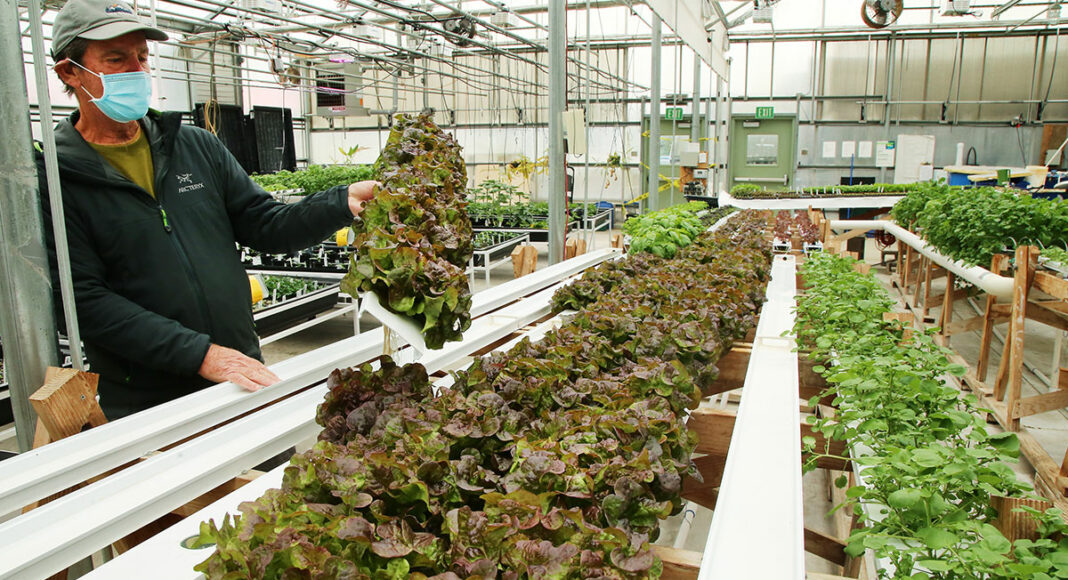The Central Coast of California is often called “the salad bowl of the world.” The Mediterranean climate of the region is perfect for year-round agriculture and horticulture, producing large amounts of the world’s veggies, fruits, and other plants.
That’s why it might be hard to understand why Cabrillo College’s Horticulture Department even bothers to grow certain common vegetables. Peter Shaw, a Cabrillo instructor who is also chair of the department, hears it all the time.
“People ask me why we grow lettuce here—it’s so abundant all around us,” Shaw says. “For one thing, it’s very easy to grow and sell. But it’s also about education. We’re trying to teach a technique to our students that will work anywhere. If you go to somewhere like Texas, you can’t grow lettuce year-round outside, but you can inside, like this. We just happen to live in a pretty unique environment.”
Hydroponic agriculture entails growing plants without soil by using different materials to support the plants’ roots, then directly submerging them in mineral and nutrient-rich water.
At Cabrillo College’s greenhouse facility, located at the very top of campus in Aptos, lettuce and other crops grow on sets of sloped tables, which feature submersible pumps placed inside a reservoir. The pumps bring the water up to one end of a table and allow the solution to trickle down with gravity, before starting the process over again.
Nearby in the school’s brand new AgTech Greenhouse, the department is currently growing high-wire crops of Persian cucumbers. Here, the plants hang suspended, growing inside a cube of rock wool, also submerged in the water.
Cabrillo’s setup also uses aquaponics, which is the practice of growing fish and other aquatic animals to use their waste as fertilizer for the plants—a symbiotic relationship benefiting both systems.
Shaw says there are many advantages of hydroponic growing, with increased production being among the biggest.
“For outside farms, they have about a few harvests of lettuce a year. Here, we get about 18,” Shaw says. “It’s a really fast turnover.”
The perfectly controlled environment of the greenhouse—the temperature, lighting, nutritional intake and care given by a staff of students—allows the crops to flourish. Shaw says that a head of hydroponically grown lettuce, with its roots still attached, can last up to two weeks inside of a refrigerator.
“A huge percentage of produce is thrown out because it’s low quality, or a lot of trimming needs to be done,” he says. “When you pick up a head of lettuce from here, every leaf is green and usable.”
Shaw says the indoor system uses about one-tenth of the water of field-grown crops. It is also easier to harvest, alleviating a lot of the bending over and reaching that traditional harvesting requires.
Hydroponic gardening is often used in areas where farming is challenging due to space or weather. This has led to organizations and companies setting up hydroponic greenhouses in urban backyards or atop buildings. One of Shaw’s former students is currently working for Gotham Greens, a major rooftop gardening company out of Brooklyn, New York.
“It’s all about hyper-local food production,” Shaw said. “It can be a really good business for smaller facilities, and is great for growing local produce in places with food deserts, where it’s harder to access fresh food.”
Many people have also started growing hydroponic crops for their own use at home, whether by setting up a small garden tower in their apartment or growing atop their aquarium or terrarium using aquaponics.
“There are a lot of ways, and a lot of places that this [method] can be used,” Shaw says, adding that there are many resources for people interested in learning about how to use hydroponics at home, such as online communities on Reddit.
“But honestly, to really see what’s going on—you should come out to a place like this,” he says.
Cabrillo’s facility currently employees six students who work alongside Shaw. Every Saturday, the team sets up a booth at the Aptos Farmers Market further down campus and sells a good deal of the produce they grow.
Shaw says that though he doesn’t think hydroponics are the “end all” of food production, they do have a big future, and their impact on the ag industry is only starting to be seen.
“This is a huge industry, and it’s becoming larger throughout the U.S. every day,” Shaw said. “Again, it might seem weird for us to do it here, since we’re already in such a great climate to grow outside. But a lot of our students aren’t going to be living here forever. This is a model you can pick up and move to wherever you go.”
To learn more about Cabrillo College’s Horticulture Department and how they are using hydroponics, visit cabrillo.edu/horticulture.













